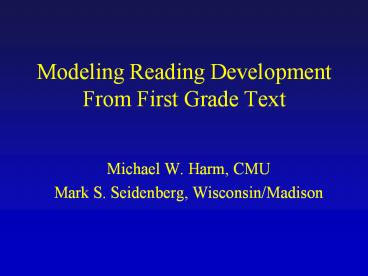Modeling Reading Development From First Grade Text PowerPoint PPT Presentation
1 / 20
Title: Modeling Reading Development From First Grade Text
1
Modeling Reading Development From First Grade Text
- Michael W. Harm, CMU
- Mark S. Seidenberg, Wisconsin/Madison
2
Why Construct Computational Models?
- Can complement empirical studies
- Allow manipulation of multiple factors that would
be prohibitively difficult in a classroom setting - We can look under the hood and see what kinds
of internal representations are formed during
learning
3
Computational Models of Reading
- Have a long history
- Rumelhart McClelland 1981, Seidenberg
McClelland 1989, Plaut Hinton, 1991, Coltheart
et. al, 1993, Plaut et. al 1996, Zorzi 1999, etc. - Historically, have been aimed at explaining
adult performance - Architecture of the reading system
- Acquired dyslexia (due to brain damage)
- Have traditionally not examined issues of reading
development
4
Modeling Development Was Difficult With Earlier
Models
- Earlier models did not learn about phonology
- But phonology is important in learning to read!
- Sampled large corpus of (adult) text in toto
- Did not allow for manipulation of actual sequence
or nature of word exposures - Prohibited examination of effects of different
basals, interventions
5
The Harm Seidenberg 1999 Model of Reading
Begin by modeling pre- literate phonological
knowledge that children have
Can vary the strength and consistency of this
knowledge
and simulate the different degrees of
phonological ability children bring to bear
learning to read
6
Reading Uses this Phonological Knowledge
The nature of the phono representations
influences what is learned during reading
Core result the phonologically impaired model
learns differently
7
Two New Applications
We have applied the Harm Seidenberg 1999 model
to two novel applications
- Simulation of effects of different instructional
basals - Simulation of an reading intervention scheme
8
Simulating Effect of Different Reading Basals
- Some early reading texts are more tuned to
overlap in spelling/sound - Others emphasize variety in text exposure to
wider range of words
Q How does this interact with reading
impairments?
9
Results Nonword Reading
- Basal 1 More tuned to spelling/sound
correspondences - Basal 2 Less systematic text
- For both normal and impaired model, Basal 1
better than Basal 2.
10
Results Word Reading
- For normal models, large effect of basal
- For impaired models, floor effect smaller
difference
11
Summary Simulating Effects of Basals
- We can explore the impact of reading materials,
and differential effects on normal and impaired
reading - Holds promise for more sophisticated
explorations/manipulations - and direct ties to more fine grained properties
of basals (see other talks in this session)
12
Simulating Reading Interventions
- There is extensive evidence that one cause of
poor reading development is a phonological
impairment - However, interventions targeted at auditory
phonology generally are not very effective - Interventions aimed at spelling/sound
representations have greater success
Why?
13
Analysis of the Model
Phonology
Spelling
So effective interventions must target the
relationship between spelling and sound
14
The McCandliss et al. Intervention
- Use lessons based on the Beck word-building
scheme - Break words apart when errors are made
- Emphasizes componential structure of words
- and its relation to components of sound
15
Performed Simulation of this Intervention
- Used phonologically impaired simulation from Harm
Seidenberg 1999 - Simulated intervention using actual items from
lessons - Brought about improvements in nonword reading
- Analyzed internal representations of words
16
Normal and Impaired Simulation
17
Representations Cluster Better Due to Intervention
Remediated Simulation
18
Conclusions
- Computational simulations are now poised to
explore more detailed aspects of childrens
experience - With reading basals
- And with interventions
- Opens up a promising new line of research linking
behavioral experimentation with computational
analysis
19
With thanks to...
Mark S. Seidenberg Bruce McCandliss
20
fin

